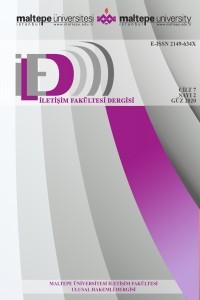Heterotopias and Confrontations: Cinema and Literature as the Mirrors of New Visions of Turkey
AbstractTurkish society is continuously exposed to various processes of social transformation. These transformations can be evaluated as the reflections of the internal and external changes with economic, political, social and cultural dimensions. Neoliberalism, globalization, political Islam and identity politics might be seen as the main phenomena that determine the forms of social changes in Turkey. These wide arrays of changes have unsurprisingly found their reflections in many different spheres of cultural production. New Turkish Cinema and Contemporary Literature of Turkey have been prominent ones among these spheres. For instance, unlike the Yeşilçam Cinema, The New Turkish Cinema has problematized and revealed the previously ignored subjects of Turkish cinema through creating new narratives. At this juncture, this study is aimed to examine the changing structure of Turkey by considering categories of class, gender and ethnicity under the grand concept of space. The theoretical framework is constituted by Michel Foucault’s notion of heterotopia and Richard Sennett’s notion of confrontation to extensively address the issue of space in Turkey. The study used the focus group technique to get other opinions on exemplifying cases.Key Words: New Turkish cinema, contemporary literature of Turkey, heterotopia, confrontation, space.
___
- Adams, M. (2007). Self and Social Change. Wiltshire: Sage.
- Arat, Y. (2009). Religion, Politics and Gender Equality in Turkey. Heinrich Böll Foundation.
- Arslan, S. (n.d.). The New Cinema of Turkey. New Cinemas: Journal of Contemporary Film, 95.
- Bıçakçı, B. (2013). Sinek Isırıklarının Müellifi. İletişim Yayınları.
- Blandy, S., Sibley, D. (2010). Law, Boundaries and the Production of Space. Social & Legal Studies, 277.
- Bonazzi, A. (2002). Heterotopolgy an Geography: A Reflection. Space and Culture, 43.
- Bondi, L. (2005). Troubling Space: Making Space, Doing Space. Group Analysis, 142.
- Boratav, H. B., Fisek, G. O., & Ziya, H. E. (2014). Unpacking Masculinities in the Context of Social Change: Internal Complexities of Identities of Married Man in Turkey. Men and Masculunities, 303.
- Buğra, A. (2007). Poverty and Citizen Ship: An Overview of the Social-Policy Environment in Republican Turkey. International Journal of Middle East Studies, 46.
- Eriş, M. Ü. (2014a). Benim Adım Feridun. In M. Ü. Eriş, Olduğu Kadar Güzeldik (p. 36). İletişim Yayınları.
- Eriş, M. Ü. (2014b). Malibu. In M. Ü. Eriş, Olduğu Kadar Güzeldik (p. 73). İletişim Yayınları.
- Foucault, M. (1984). Of Other Spaces: Utopias and Heterotopias., (p. 9).
- Göle, N. (1998). Modernleşme Bağlamında İslami Kimlik Arayışı. In S. Bozdoğan, & R. Kasaba, Türkiye’de Modernleşme ve Ulusal Kimlik. Tarih Vakfı Yurt Yayınları.
- Harvey, D. (1991). The Condition of Postmodernity: An Enquiry into the Origins of Cultural Change. Wiley-Blackwell.
- Howarth, D. (2006). Space, Subjectivity and Politics. Alternatives: Global, Local, Political, 110.
- Keyman, F. E., Koyuncu, B. (2005). Globalization, Alternative Modernities and the Political Economy of Turkey. Review of International Political Economy, 109.
- Kitzinger, J., Barbour, R. S. (1999). Introduction: the challange and promise of focus groups. In R. S. Barbour, & J. Kitzinger, Developing Focus Group Research (p. 4). Sage.
- Johnson, P. (2006). Unravelling Foucault's 'different spaces'. History of the Human Sciences, 78, 82.
- Mills, A. (2006). Boundaries of the nation in the space of the urban: landscape and social memory in Istanbul. Cultural Geographies, 375.
- Özcan, G. B., Turunç, H. (2011). Economic Liberalization and Class Dynamics in Turkey: New Business Groups and Islamic Mobilization. Insight Turkey, 70.
- Phipps, A. (2014). The Politics of the Body: Gender in a Neoliberal and Neoconservative Age. Cambridge: Polity Press.
- Sanders, E., Williams, C. (2003). Hernessing People's Creativity: Ideation and Expression through Visual Communication. In J. Langford, & D. McDonagh, Focus Groups (p. 147). Taylor&Francis.
- Sassen, S. (2013). Does The City Have Speech? Public Culture, 25, 217,218.
- Saunders, A. (2009). Literary Geography: Reforging The Connections. Progress in Human Geography, 441.
- Sennett, R. (2002). Reflections on the Public Realm. In G. Bridge, & S. Watson, A Companion to the City (p. 386). Wiley-Blackwell.
- Shilling, C. (1993). The Body and Physical Capital. Sage.
- Söğüt, M. (2003). Beş Sevim Apartmanı. İstanbul: Yapı Kredi Yayınları. Soja, E. W. (2011). History: Geography: Modernity. In E. W. Soja, Postmodern Geographies: The Reassertion of Space in Critical Social Theory (p. 16, 20). Verso.
- Tuğal, C. (2009). Transforming Everyday Life: Islamism and Social Movement Theory. Theory and Society, 443.
- Yayın Aralığı: Yılda 2 Sayı
- Başlangıç: 2014
- Yayıncı: Maltepe Üniversitesi
